#Marquez 1950
Explore tagged Tumblr posts
Text
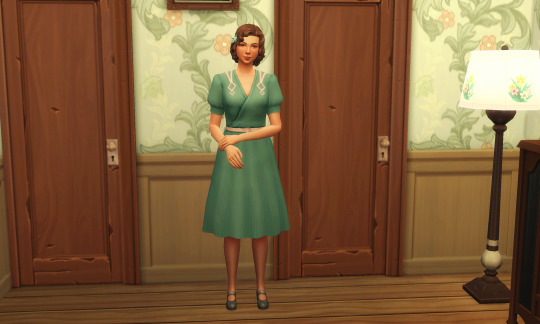
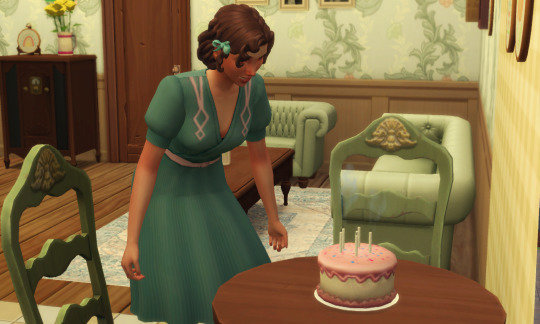

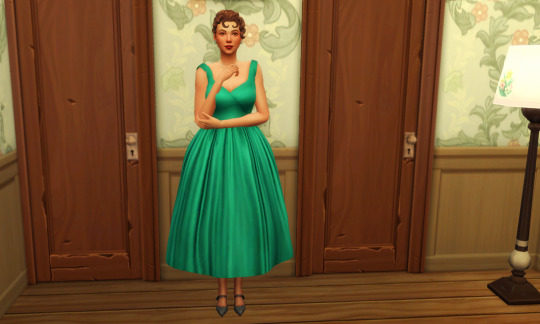
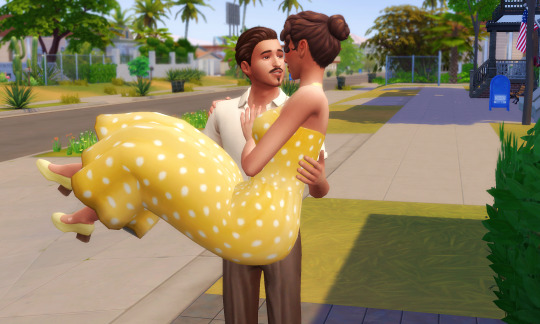

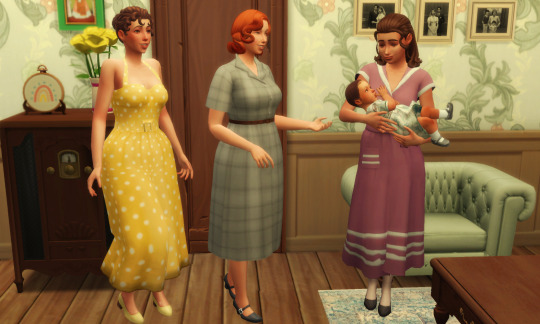

Gloria's Diary
Eighteen at last! I got the most gorgeous teal dress for my birthday with a full skirt, and I must say I look stunning! Goodbye to high school— but Salim will be attending a local university to earn a business degree. (More of his parents' idea than his own, as his real passion lies with writing.)
I've thought about whether I'd want to go to college too, but Mom says that's not necessary as a man will provide for me someday. And if Salim asked me to marry him, I would accept without a doubt. I'm confident he and I could build a beautiful life together.
When Salvador is working, Mary sometimes comes to visit Mom and me with baby Estela and she is ADORABLE! I can see it now, the kind of life I'd want with Salim, with children of our own, after he graduates of course.
#Marquez 1950#Marquez gen7#Gloria Morales#Salim Benali#Alexandrea Cole#Mary Guerra#Estela Morales#ts4 gameplay#ts4 historical#random decades challenge#1950s#new generation let's GO#also yeah the dress is supposed to be teal but looks green with the PSD I used
30 notes
·
View notes
Text


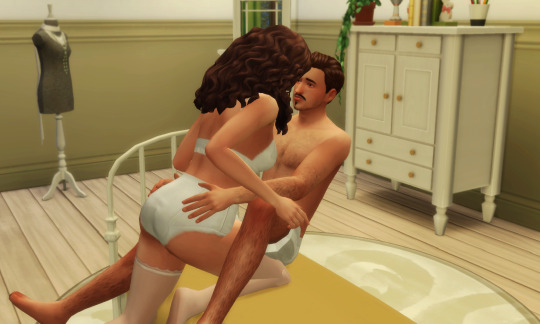






I've loved you three summers now, honey, but I want 'em all 🎶
1 note
·
View note
Note
Hey Mimi do you have any recommendations for books set in Latin America (any genre) ?
So I am going to assume that you are not asking for picks like Gabriel Garcia Marquez or Isabel Allende. Most of the Latinx authors I read are unfortunately fantasy or genre fiction set in the USA (I'm trying to remember if Tehlor Kay Mejia or Anna-Marie McLemore wrote a book that is explicitly set in a Latin American country.)
Here are a couple of books I enjoyed, or at least feel confident recommending based on what I remember:
Certain Dark Things by Silvia Moreno-Garcia (adult, urban fantasy, horror): Described by the author as a "violent neo-noir", this story is set in an alternate, gritty Mexico City, and follows a Tlāhuihpochtli vampire who strikes a bond with an impoverished street kid, while fleeing from narco-vampire clans, criminal gangs, and other dangers lurking in the dark underbelly of the city.
Gods of Jade and Shadow by Silvia Moreno-Garcia (adult, historical fiction, fantasy): In 1920s Mexico, a young woman accidentally frees the spirit of the Mayan God of Death, and embarks on a cross-country mission with him: from the dazzling Jazz Age opulence of Mexico City, into the darkness of the Mayan underworld– where she must face great dangers to reinstate the God on his rightful throne.
Mexican Gothic by Silvia Moreno-Garcia** (adult, historical fiction, horror): A glamorous, fun-loving socialite in 1950s Mexico receives a disturbing letter from her married cousin, prompting her to travel down to their ancestral mansion, where the in-laws' live. There, on that ancient, colonial estate, she begins to be haunted by an equally ancient evil, and soon realises something is terribly wrong about the family her cousin has married into.
Tender is The Flesh by Agustina Bazterrica** (adult, dystopia, horror): In a near-dystopian future, an infectious virus turns all animal meat poisonous and unfit for consumption, forcing governments to legalize the factory-farming, breeding and eating of human meat. At one such processing plant, a worker is faced with a moral dilemma when he is gifted a "live" specimen.
Elena Knows by Claudia Piñeiro (adult, psychological thriller): Set in Argentina, this is a claustrophobic, uneasy novella about a mother's journey to uncover the truth behind the hushed-up murder of her dead daughter; the investigative mission, however, is made difficult by her advanced locomotive disability and age, as well as by this slowly unfurling realization: that she may not have known her daughter as truly as she thought.
And a couple I have not read/read and did not enjoy at all, but would recommend because my opinion seems to be in the minority:
Jawbone by Mónica Ojeda** (adult, horror, thriller, LGBTQ): A group of wealthy teenage girls attending an elite academy in Ecuador begin to convene regularly in an abandoned building, after school hours– but what started out as a place to exchange ghost stories, soon devolves into a site of dangerous thrill-seeking and dark, bloody rituals. (Note: I absolutely despised it, but you may enjoy; it's sapphic dark academia with cosmic horror and yellowjackets vibes).
Our Share of Night by Mariana Enríquez (adult, horror, historical fiction, fantasy): Set partially during the years of Argentina's brutal military dictatorship, this novel follows a father and son on a road trip, trying to escape a death cult, who have committed unspeakable atrocities. I have not read this gigantic tome, but I really want to, I am a sucker for horror rooted in political/historical allegories.
Cantoras by Carolina De Robertis (adult, historical fiction, LGBTQ): In 1977 Uruguay, a time when oppressive militia rule criminalized homosexuality as a dangerous transgression, five queer women discover an uninhabited cape, and claim the coastal sanctuary for themselves. Over years, it becomes their one safe haven, to be their true selves. Not read this, but it sounds strikingly similar to Last Summer at Bluefish Cove, one of my favourite queer stories of all time.
[ Note: All the stories are adult and given my inclination towards horror and psychological fiction, they are likely to be dealing with sensitive issues, but for the stories marked ** I very highly recommend checking trigger warnings ]
#mimiwrites#answered ask#faewong#book recs#books#book recommendations#horror#latin american literature#latin america#horror books#litblr#studyblr#silvia moreno garcia#mexican gothic#dark academia#our share of night#queer books#queer#lgbtq#tender is the flesh#translated literature#translated fiction#dystopia#historical fiction#yeah
177 notes
·
View notes
Text
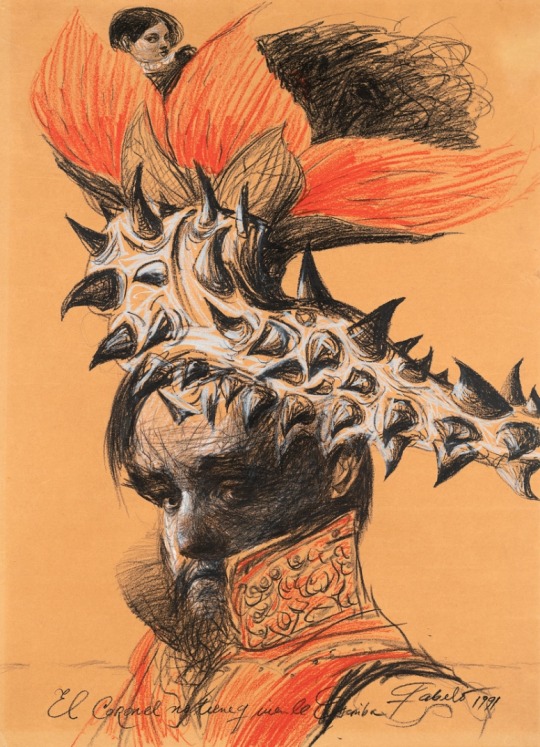
Roberto Fabelo (Cuban, b. 1950)
El Coronel No Tiene Quien Le Escriba.Garcia Marquez, 1998
Colored pencil
48 notes
·
View notes
Text
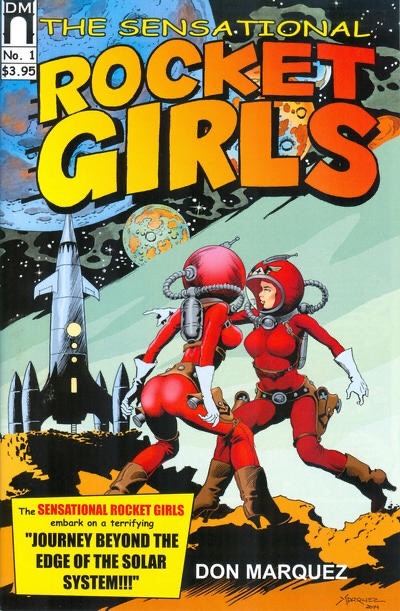
The Sensational Rocket Girls are a non-too-serious retro set of space heroines created by artist and storyteller Don Marquez in 2015. His (to date) four-issue series features an all female crew of space mechanics, salvage experts and adventurers operating on the edge of the solar system in the 23rd century. Picking up a mysterious distress signal, the Rocket Girls set off to discover its source, which takes them beyond the solar system and into a barely explored zone known as The Scattered Disc.
Marquez’s cover art is shamelessly based on 1950s exploitative movie posters and covers to SF pulp magazines, featuring unfeasibly tight space costumes and large breasts. Inside the comics’ pages however, the stories themselves, while undeniably camp, have a much more serious edge and the Rocket Girls themselves are depicted as intelligent and relatively normal proportioned young women. In the course of their adventures they encounter genetically-engineered half insect monsters, renegade interstellar villains and lovestruck heroines, in true classic adventures style.
For all I know, Marquez will issue further editions of the Space Girls, which I really hope is the case because they just don’t make feisty light-hearted heroines like this anymore.
Source: Amazon
#women in comics#strong woman#space adventure#the sensational space girls#don marquez#retro comics#DM Publishing
7 notes
·
View notes
Text

Lorraine Vélez (November 2, 1964) is a singer and actress, who has specialized in musical theatre. Her name has sometimes appeared as Loraine Velez. She is the identical twin sister of actress Lauren Vélez.
Her parents moved from Puerto Rico in the early 1950s and lived in Brooklyn. The twins were born in Brooklyn. They have five other sisters and one brother. Their father was a New York City Police Department officer. They each received scholarships to attend the Alvin Ailey Dance School. They both went on to study acting at the Acting Studio.
Her first professional job was singing and acting for the Theater for the New City. She went on to play in Dreamgirls at the Ambassador Theater on Broadway, and she performed in the off-Broadway production of Does a Tiger Wear a Necktie? She played Leah and Sister Hilton in the original Black Nativity, Young Maria in Maria de Buenos Aires, and Anita in West Side Story. In the independent film A Day Out of Days, she took the role of Roxanne. With a production of Blues in the Night, she toured throughout Central and South America, and she sang in Japan and France.
She moved to London, where she worked regularly for a number of years on the West End stage. She played Carmen in the original cast of the musical Fame. He recorded the title track of the Fame CD.
She played Hannah in Out of the Blue, Lena Horne in Mama, I Want to Sing!, and Gigi in Miss Saigon. She featured as Heidi in Frightmares. She took part in the production of Rent and cast in the role of Mimi Marquez.
She performed the role of Mimi on Broadway. She was cast as Tutu in Piñero. She was a guest artist on The Rosie O’Donnell Show and HBO Latino, she played Abby Bishop ion Law & Order. She was on a Buddhist retreat (2008-09). She sang for the Dalai Lama.
She starred in Off-Broadway musical DC7, The Life of Roberto Clemente, in the role of Clemente’s wife, Vera Zabala. She took the show to Puerto Rico and was awarded the New York Latin ACE Award for best actress in a musical production. She continues to make TV and stage appearances, and she played Claudia in Elementary.
She is divorced with one adult son. #africanhistory365 #africanexcellence
0 notes
Text
POST-EDSA 1 REVOLUTION: 2 REMARKABLE FILIPINO WRITERS

Nicomedes Marquez Joaquin
Short biography:
Nick Joaquín was a Filipino writer born in 1917 to a prosperous and deeply Catholic family in Manila. Although his father was once a popular lawyer, their family fortune was lost in the 1920s. Nick dropped out of school and later worked at the Tribune publishing company. He gained recognition after World War II with the publication of his signature stories like "Summer Solstice" and "May Day Eve." He was also a public figure in Philippine letters and joined the Philippine Free Press in 1950. His notable works include the novel The Woman Who Had Two Navels and the play A Portrait of the Artist as Filipino. Nick Joaquín was conferred the rank and title of National Artist of the Philippines for Literature and considered one of the most important Filipino writers.
Contribution:
Nick Joaquín's contribution to Philippine literature includes his writings on the Spanish colonial period, exploration of the Filipino heritage, and the intricacies of human nature. He was honored as a national artist for literature in 1976.
Reference:
Nick Joaquin: The Biography. (n.d.). http://kathangpinoy.blogspot.com/2014/04/nick-joaquin-biography.html?m=1
Photo source: https://en.m.wikipedia.org/wiki/File:Nick_Joaquin_Portrait_from_Fringe.jpg

Carlo Magno Jose Caparas
Short biography:
Carlo Magno Jose Caparas (born December 15, 1948) is a Filipino comic strip creator, writer, film director, and producer. He is well-known for creating popular Filipino superheroes and comic book characters such as Panday, Bakekang, Totoy Bato, Joaquin Bordado, Kamagong, Kamandag, Elias Paniki, Tasya Fantasya, Gagambino, Pieta, and Ang Babaeng Hinugot sa Aking Tadyang. He is also recognized as a director of numerous films, including massacre films like Kuratong Baleleng and The Cory Quirino Kidnap: NBI Files. Caparas has received various awards and recognition for his contributions to Philippine popular culture, and he continues to be a prominent figure in the Philippine entertainment industry.
Contribution:
He is best known for creating such Filipino superheroes and comic book characters as Panday, Bakekang, Totoy Bato, Joaquin Bordado, Kamagong, Kamandag, Elias Paniki, Tasya Fantasya, Gagambino, Pieta and Ang Babaeng Hinugot sa Aking Tadyang, among others.
Reference:
Wikiwand - Carlo J. Caparas. (n.d.). Wikiwand. https://www.wikiwand.com/en/Carlo_Caparas
Photo source: https://mydramalist.com/people/42319-carlo-j-caparas
0 notes
Text
FAMOUS FILIPINO WRITERS

Photo edit: https://businessmirror.com.ph/2019/07/05/when-the-nation-was-an-easy-street/
PAZ MARQUEZ- BENITEZ
Paz marquez was a celebrated filipino writers, known for her contribution to philippine literature the early 20th century. She was born on March 3, 1884, in Lucena City Quezon Province, Philippines and grew up in a family of intellectuals.
Benitez received her education at the University of Philippines, where ahe became involve in various literary organization and publication. In 1925, she wrote her famous work, the short story "Dead Star" which was published the Philippine history and has since became a classic of Philippine.
"Dead Star" explores theme of love and regret and the passage of the time and its noted for its vivid characterization and masterful use for language. The story also reflected tension between tradition and modernity in the Philippines society, which were becoming increasingly pronounced during the early 20th century.
Benitez was also deducted teacher and educator. She taught English and Literature at the University of the Philippines for over three decades and was known for her committed to promoting the values of education and social responsibility
Paz Benitez passed away on November 10, 1983 at the age of 89. Ther legacy as a writers and educator continues to inspire generations of Filipino.

photo edit: https://www.carlospromulo.org/bio
CARLOS ROMULO
Carlos P. Romulo was born on January 14, 1899, in Camiling, Tarlac, Philippines. He was the son of Gregorio Romulo, a former mayor of Camiling, and Margarita Pecson. Romulo's parents were both educated and had high aspirations for their children. Romulo's father encouraged him to pursue an education in law, which he did, graduating from the University of the Philippines in 1918.
Romulo began his career as a journalist and worked as a reporter for various newspapers in the Philippines and the United States. He then went on to work for the Manila Bulletin, where he eventually became editor-in-chief. In 1941, he was awarded the Pulitzer Prize for his coverage of the war in Europe.During World War II, Romulo served as an aide to General Douglas MacArthur and played a significant role in the liberation of the Philippines from Japanese occupation. After the war, he served as the Philippines' ambassador to the United States from 1946 to 1952. He was also the president of the United Nations General Assembly from 1949 to 1950.
In addition to his political and diplomatic career, Romulo was also a prolific writer. He wrote numerous books, including his autobiography, "I Walked with Heroes," and the Pulitzer Prize-winning play, "The Shroud of Darkness." He was also a regular contributor to various newspapers and magazines, including the New York Times.Romulo was known for his eloquence and his passionate advocacy for the Philippines and the Filipino people. He was a staunch defender of democracy and human rights and played a significant role in shaping the political and social landscape of his country.
1 note
·
View note
Text
We Don't Talk About Bubo...
...and that's a real shame.
Now, let me make something clear: The writers of Encanto were right to cut Bubo Marquez and his arc with Isabela from the movie. It would've crowded the plot, and at the time, it was unnecessary for Isa to have a love interest or for Mariano to have any kind of rival. But that does not mean Bubo is a worthless character who deserves to be hated. His intended role in the film, along with the character design, reveal something very important about Isabela: She inherited her mother's tastes. I mean, look at this dork!

He's basically Agustín, but as a student in the 1950s.
What's more, because we never officially met Bubo, he is a blank slate. He can be pretty much anything you want him to be. We know he's interested in nature and knows (or thinks he knows) a few things about wild animals and/or survival. We know he was named after an owl for some reason. And we know he's notably shorter than Isa. But beyond that, the man is a mystery. A tabula rasa. We can do whatever we want with him. So that's what I did.
Bubo appears in my fic Patchwork (currently on hiatus due to the need to rework a couple of chapters). Part of my intention with that fic was to establish my own head canon for this character. Since I don't know when (or if) I'll finish that fic, let me share my own personal Bubo head canon with you all.
Bubo is from Bogotá.
He has an older sister named Rosa. Rosa suffers from lupus and also has vitiligo.
Bubo and Rosa attend a university in Bogotá--Bubo as an undergrad and Rosa as a graduate working on her doctorate.
The two of them are very close.
Bubo is shorter than Rosa, so she will never not get to refer to him as her little brother.
Bubo has been interested in ornithology since he was a child. His favorite bird is the great horned owl. His friends eventually nicknamed him Bubo because he would not stop talking about the owl, always calling it by its binomial, Bubo virginianus.
His real name is Alfonso.
Bubo is studying wildlife biology.
When Bubo meets Isabela, they hit it off right away, and agree to write one another.
Isa also becomes good friends with Rosa.
Bubo eventually visits the Encanto, where he meets Antonio and begs him to help him find the rare Andean condor.
Isa and Bubo date for a while, but nothing really comes of it, and their paths eventually diverge for a time. Bubo, Rosa and Isa remain good friends, however.
Whether or not Bubo and Isa ever get back together, I don't know.
25 notes
·
View notes
Text
1890s No CC Couples!
Gallery ID: HawkeyeTARDIS
I mentioned in a previous post that I had a project going of making couples/families for the Decades Challenge using no CC. Meet the families of the 1890s!

Edith and Jasper Mason

Camila, Ana Luisa, and Pedro Marquez
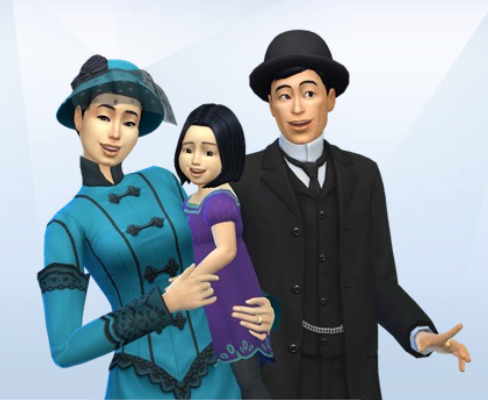
Yan, Xiulan, and Shen Li (*I know that Chinese naming conventions place the family name first- but for purposes of family tree and how EA lineage works, I went with the western naming convention)
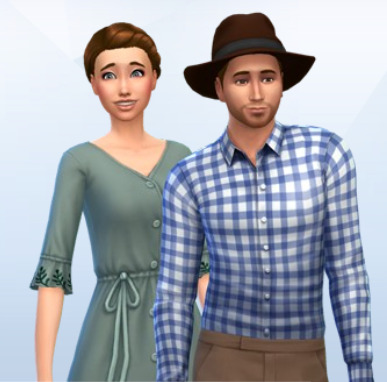
Mary and William Smith - my original Decades founders years ago. Not as period accurate, but dressed less fancy than the other families.
All of these sims have been dressed time period appropriately for all outfit categories. Use them as you wish! Enjoy!
1890s/1900s/1910s/1920s/1930s/1940s/1950s/1960s
#ts4 decades challenge#no cc#no cc sims#sims 4 historical#sims 4 history challenge#1890s af#1890s am#1890s toddler#sims 4#sims 4 decades challenge#jenplayssimstownies#CC free sims
49 notes
·
View notes
Text









Gloria began basic nursing training at a hospital to prepare for becoming a volunteer army nurse and going to Korea to serve. Some afternoons after her classes, she met up with Betsy, Naomi, and June to stroll around the city and look in the windows of their favorite shops. Meanwhile, between his college classes, Salim enjoyed writing short stories for the campus literary magazine, as well as reading, often stopping by the Morales apartment to do so.
As the date for her to leave for Korea neared, Gloria found her conversations with Salim becoming more serious, with a sense of underlying urgency. Though he hadn't proposed yet, he had broached the topic several times. "After you come back and after I graduate, we should get married, Inshallah."
"Of course. Nothing would make me happier, my love," she said. Emboldened by his promise, Gloria felt herself confident enough to take the next step. Shortly before she was set to leave, one thing led to another, and any anxiety Gloria may have had melted away in Salim's arms.
#Marquez 1950#Marquez gen7#Gloria Morales#Naomi Foye#June Kay#Betsy Giordano#Salim Benali#1950s#ts4 historical#ts4 gameplay#random decades challenge#THEM!!! my heart
17 notes
·
View notes
Photo
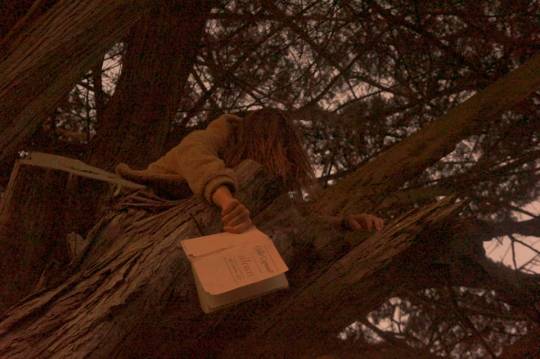
To continue on yesterday’s vein, here’s my eternally stretching books-that-moved-me list:
1. Silences - Gilles Vigneault
2. Strange Pilgrims - Gabriel Garcia Marquez
3. Je viens d’ailleurs - Chahdortt Djavann
4. Franz Kafka - Letters to Felice
5. A personal matter - Kenzaburo Oe
6. Tranformation - Joyce Tenneson (photography)
7. Grapefruit - Yoko Ono (a book of instruction)
8.Can you ever forgive me? - Lee Israel
9. Cesare Pavese - The business of living (diaries 1935-1950)
10. Letters to father - Franz Kafka
11. The diaries of Franz Kafka
12. Letters to Milena - Franz Kafka
13. Ashes and snow Book No.1 - Gregory Colbert (photography)
14. Norwegian Woods - Haruki Murakami
15. Just kids - Patti Smith
16. Silk - Alessandro Baricco
17. The unknown craftsman: a Japanese insight into beauty - Yanagi Sōetsu
18. Americanah - Chimamanda Ngozi Adichie
19. Small country - Gaël Faye
20. Deep water - Patricia Highsmith
21. La bulle d’encre - Suzanne Jacob
22. The writing life - Annie Dillard
23. A field guide to getting lost - Rebecca Solnit
24. Teaching on love - Thich Nhat Hanh
25, The stranger in the woods - Michael Finkel
26. The trial - Franz Kafka
27. The dinner - Herman Koch
28. In Cold blood - Truman Capote
29. In the country of last things - Paul Auster
30. The bell jar - Sylvia Plath
31. She’s come undone - Wally Lamb
32. The catcher in the rye - J.D Salinger
33. Amititau! Parlons-nous! - Laure Morali
34. Document 1 - François Blais
35. Demian - Herman Hesse
36. All these wonders - The moth
37. Cave in the snow - Vicki Mackenzee
Yes, this is me, in a tree, with Gilles Vigneault resting in my hand.
Share if we share most-loved bookies.
Tell me what your favorite books are.
#books and libraries#books#reading#franz kafka#gabriel garcía márquez#literature#sylvia plath#murakami#yoko ono#list#photography#film camera#trees
95 notes
·
View notes
Note
Hi! Would you happen to know if nia peeples has playable resources somewhere? So far she’s the only filipino fc I found that fits my characters age range (in her 50/60s), but I couldn’t find much… unless I don’t know how to look for that, which is totally possible too. Thanks for the help!
Pilar Pilapil (1950) Filipino.
Marissa Delgado (1951) Filipino.
Gloria Diaz (1951) Ilocano and Spanish Filipino.
Coney Reyes (1954) Tagalog Filipino.
Chanda Romero (1954) Filipino [including Spanish].
Charo Santos-Concio (1955) Filipino [including Spanish].
Raquel Monteza (1955) Filipino / Unspecified American.
Dexter Doria (1955) Filipino.
Evangeline Pascual (1956) Filipino.
Maria Isabel Lopez (1957) Filipino.
Ces Quesada (1958) Filipino.
Evangeline Pascual (1958) Filipino.
Elizabeth Oropesa (1958) Bicolano Filipino.
Malou de Guzman (1958) Filipino.
Isabel Rivas (1958) Filipino and Chinese.
Susan Africa (1959) Filipino.
Sandy Andolong (1959) Tagalog Filipino.
Nia Peeples (1961) Filipino / Scottish, English, and Irish.
Amy Austria (1961) Filipino.
Rio Locsin (1961) Tagalog Filipino.
Suzette Ranillo (1961) Filipino.
Tetchie Agbayani (1961) Filipino.
Lorna Tolentino (1961) Kapampangan and Spanish Filipino.
Liz Alindogan (1962) Bicolano Filipino.
Irma Adlawan (1962) Filipino.
Cherie Gil (1963) Filipino / Filipino, German, Swiss - including Spanish.
Carmi Martin (1963) Filipino.
Zsa Zsa Padilla (1964) Filipino.
Melissa Mendez (1964) Filipino.
Jackie Lou Blanco (1964) Filipino [including Spanish].
Ai-Ai delas Alas (1964) Filipino.
Jaclyn Jose (1964) Filipino.
Melanie Marquez (1964) Kapampangan Filipino.
Maila Gumila (1965) Filipino.
Shamaine Buencamino (1965) Filipino.
Bb Gandanghari (1965) Filipino - trans woman.
Maricel Soriano (1965) Filipino.
Pops Fernandez (1966) Filipino.
Snooky Serna (1966) Filipino [including Spanish].
Ruby Rodriguez (1966) Filipino [including Spanish].
Pinky Amador (1966) Filipino [including Spanish].
Agot Isidro (1966) Filipino / Palestinian.
Yayo Aguila (1967) Filipino.
Christine Jacob (1967) Filipino / German American.
Tia Carrere (1967) Spanish, Chinese and Bisaya Filipino - sometimes said to be Native Hawaiian too but unsure.
Eula Valdez (1968) Filipino.
Janice de Belen (1968) Filipino.
Lovely Rivero (1969) Filipino.
Maritoni Fernandez (1969) Filipino / English, Irish.
Jean Garcia (1969) Kapampangan Filipino.
Alice Dixson (1969) Filipino / Unspecified American.
Jaya (1970) Bisaya Filipino / Afro-Jamaican and Spanish Filipino.
Regine Velasquez (1970) Tagalog Filipino.
Cherry Pie Picache (1970) Kapampangan Filipino.
I sadly couldn't find any roleplay resources for Filipino women in their 50/60s at the time of posting but here are some more suggestions along side yours! They've all been in recent media too if any resources makers need suggestions!
16 notes
·
View notes
Text
Prompt 13 Rec List
Here are some recs for prompt 12 of the Diverse Reading Challenge 2022. Full prompt list is here
Prompt 13 - A magical realism book by a Latinx author
Dark and Deepest Red - Anna-Marie McLemore
A YA book. In 1518 a mysterious dancing plague takes hold of a city, and rumors of witchcraft spread. In the modern day, a teen girl puts on a pair of red shoes, that makes her dance uncontrollably. The prose is gorgeous and lush, and it is an interesting fairy tale retelling.
Her Body and Other Parties: Stories - Carmen Maria Machado
This is a collection of short stories, focusing on women’s lives and the violence inflicted on women’s bodies. They are haunting, and memorable, with gorgeous prose.
Note: I have not personally read the following books, but they are on my to read list.
Each of Us a Desert - Mark Oshiro
A YA novel, it follows Xo who is destined to wander the desert alone. Her one wish for a companion is granted, as she and another girl must journey across the desert together.
Mexican Gothic - Silvia Moreno-Garcia
Set in 1950′s Mexico, it follows Noemi, who journeys to an isolated mansion, after receiving a mysterious letter from her cousin.
One Hundred Years of Solitude - Gabriel Garcia Marquez
A classic novel, it tells the history of the Buendiá family, and the rise and fall of the town of Macondo.
6 notes
·
View notes
Text
Reading Challenge 2021 (50/50)
vẫn đang cập nhật...
Mình có thể đọc một quyển sách dày nghìn trang trong hai ngày, rồi khóc vì nó suốt một tháng sau đó. Đấy, lý do mình đọc chậm đấy.
Mục tiêu đọc năm nay (thay đổi theo tâm trạng, nhưng vẫn là những gì mình muốn làm):
Đọc càng nhiều Murakami càng tốt, để ít nhất nắm được một cách khái quát lối viết và cách xây dựng cốt truyện chung của ông. Không có ý định trở thành người hâm mộ.
Đọc cho hết những cuốn kinh điển đã có trên giá từ lâu, như Chúa Nhẫn, Bóng ma trong nhà hát, Trăm năm cô đơn, Đồi gió hú, Giã từ vũ khí. Thật ra thì sau môn Văn học tiếng Anh kỳ trước, mình cũng hiểu được sự cần thiết của việc đọc tác phẩm kinh điển rồi.
Đọc thêm văn học Việt Nam hiện đại. Nguyễn Huy Thiệp, Ma Văn Kháng, Chu Lai là những cái tên hiện tại mình đang có trong đầu.
Đọc nhiều truyện ngắn giả tưởng hơn để dịch cho @thenutcrackers2021.
Còn dưới đây là số sách mình đọc từ đầu năm tới giờ:
Tháng 1
1. Khu vườn bí mật (1911) - Frances Hodgson Burnett
2. Mùa thu của cây dương (1997) - Kazumi Yumoto
3. Người minh họa (1951) - Ray Bradbury
4. 1Q84 (2009) - Haruki Murakami
5. Tôi là một con lừa (2013) - Nguyễn Phương Mai
Tháng 2
6. Bản chất của người (2014) - Han Kang
7. Kafka bên bờ biển (2002) - Haruki Murakami
8. Khu vườn mùa hạ (1992) - Kazumi Yumoto
9. Trăm năm cô đơn (1967) - Gabriel Garcia Marquez
10. Cảnh đồi mờ xám (1982) - Kazuo Ishiguro
11. Nhà hàng ở tận cùng vũ trụ (1980) - Douglas Adams
Tháng 4
12. Sáu kẻ bất hảo & Phi vụ bất khả (2015) - Leigh Bardugo
13. Mưu ma chước quỷ & Giang hồ hiểm ác (2016) - Leigh Bardugo
Tháng 5
14. Tử thần sống mãi (2010) - Lưu Từ Hân
15. Miền xanh thẳm (2000) - Trần Hoài Dương
16. Anh chàng Hobbit (1939) - J. R. R. Tolkien
Tháng 6
17. Chúa tể những chiếc nhẫn (1954) - J. R. R. Tolkien
Tháng 7
18. Đồi gió hú (1847) - Emily Bronte
19. Annihilation (2014) - Jeff VanderMeer
20. Killing Commendatore (2017) - Haruki Murakami
21. The Ice Storm (1994) - Rick Moody
22. Hồi ký viết dưới hầm (1864) - Fyodor Dostoyevsky
23. Đom đóm (1995) - Haruki Murakami
24. Tàn tro (2011) - Mike Mullin
25. The Adventures of Tom Bombadil (1962) - J. R. R. Tolkien
26. Shadow and Bone (2012) - Leigh Bardugo
27. Siege and Storm (2013) - Leigh Bardugo
28. Ruin and Rising (2014) - Leigh Bardugo
29. The Language of Thorns (2017) - Leigh Bardugo
Tháng 8
30. Người trộm bóng (2010) - Marc Levy
31. Terminal Boredom (1978) - Izumi Suzuki
Tháng 9
32. The Bumblebee Flies Anyway (1983) - Robert Cormier
Tháng 10
33. Phía Tây không có gì lạ (1929) - Erich Maria Remarque
34. Catfishing on CatNet (2019) - Naomi Kritzer
35. Fire Watch (1985) - Connie Willis
36. Thần thoại Bắc Âu (2017) - Neil Gaiman
37. Peter Pan (1911) - J. M. Barrie
38. Thăm thẳm mùa hè (2018) - Nguyễn Dương Quỳnh
39. Trường ca Achilles (2012) - Madeline Miller
40. Oscar và bà Áo Hồng (2002) - Eric-Emmanuel Schmitt
41. Ngược đường Trường Thi (1939) - Nguyễn Triệu Luật
42. Từ thăm thẳm lãng quên (1996) - Patrick Modiano
43. Ở quán cà phê của tuổi trẻ lạc lối (2011) - Patrick Modiano
44. Dune (1965) - Frank Herbert
Tháng 12
45. The Martian Chronicles (1950) - Ray Bradbury
46. La Belle Sauvage (2017) - Philip Pullman
47. Một thoáng ta rực rỡ ở nhân gian (2019) - Ocean Vuong
48. Kindred (1979) - Octavia E. Butler
49. Impossible Things (1993) - Connie Willis
50. Xứ Phẳng (1884) - Edwin A. Abbott

9 notes
·
View notes
